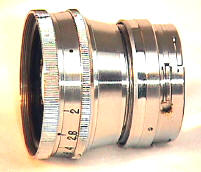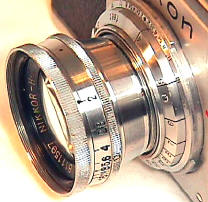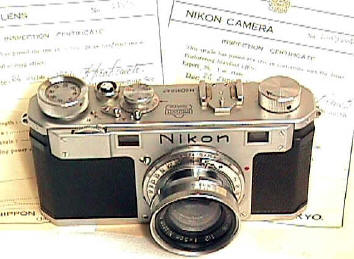

CameraQuest Home Shopping Cart Price List Camera Articles I Buy / Wants Repairs Books Adapters


Nikon M Rangefinder Unsynced
Introduced in 1949, the Nikon M (for Modified) is the second Nikon model after the original Nikon One.
This model change was necessary because the Nikon One's 24x32mm format film size would not fit into a standard US film mount. (For those of you who slept though history class, the American Army under General MacArthur occupied Japan after W.W.II from 1945 to 1951.) Apparently the odd film size kept the Nikon One from being officially exported to the US. Oddly enough, the M's film gate was only increased to 24x34, not 24x36. The later Nikon S continued the 24x34 size. Nikon would not have a standard format 24x36 until the Nikon S2 of 1955.
ALL Nikon M's are marked "Made in Occupied Japan." Earlier M's are marked on the baseplate near the tripod socket. The later ones are marked less auspiciously on the back with a stamp in the leatherette. Earlier M's have a duller chrome finish than the later M's. While M's were made only from 1949 to 1951, many variations exist because of the quick advances Nippon Kogaku was going through at the time. Never heard of Nippon Kogaku? That's Nikon before they changed their name to Nikon! The NK logo is on the top of all Nikon rangefinders. Serious Nikon collectors compare the many small variations of the One's and M's. The rest of us wish we could afford one.
There are two main types of M's, with and without flash sync. Unfortunately, collectors disagree on model terminology. American collectors refer to the earlier version as the "Unsynced M," and the later version as "Synced M's." Nikon and Japanese collectors refer to the same model as the M, while calling the second version an early S or a MS. M's of either version are very hard to find. Whatever you call them, only about 1600 of the first version and 1650 of the second version were produced.
The Nikon One, the Nikon M, and the Nikon S look pretty much alike. Each share:
- An inexact copy of the pre-war Zeiss Contax rangefinder mount. Unusually, the helical is built into the body for most normal 50 mm lenses. This makes for unusually small 50's which fit into an inner bayonet mount. There is also an outer bayonet mount for the other lenses (wide & tele) and the reflex housing. While Nikon apparently meant to copy the Contax mount exactly, they failed to measure it properly and ended up with a helical which focused at a slightly different rate than Zeiss. In practical terms you can interchange wide angles on the two systems, but as the focal length increases, the more likely you are to see a difference in focus.
- A Leica type shutter -- a big improvement in reliability over the Contax
- A combination Leica type viewfinder with a Contax style rangefinder
- A pre-war Contax style body with removable back and double film back locks
- Knob film wind and film rewind
- Comparatively bright RF image, but small 50 VF area
- A relatively heavy and slow working body design
Nikon M normal lenses include the collapsible 50/3.5, the collapsible 50/2, a 50/2 collapsible hybrid lens, the 50/1.5, the 50/1.4 with a starting serial number of 5005xxx, a 50/1.4 with a starting serial # of 316xxx, and a rigid 50/2 starting serial # 617xxx.


The Rare 50/2 Collapsible Nikkor, shown in collapsed and extended position. This lens was only made for the Nikon One and the Unsynced Nikon M.


Extremely Rare 50/2 Hybrid Rigid-Collapsible lens, made for the unsynced M. It seems to be a collapsible lens, with a hollow cone added to keep the lens from collapsing. I wonder if a lot of them have had the cone removed, thus accounting for the rarity of the hybrid lens far beyond its expected production range. This is also shown mounted on the M at the top of this page.
Early 50/1.5 Nikkor, made for the unsynced M. This was Nikon's first "Super Speed" lens. It's easy to mistake for a 50/1.4 as they look almost alike at a quick glance.
Many a seller or buyer has been unhappily, or happily, surprised by confusing a 50/1.5 and 50/1.4.

Early 50/1.4 from the first 5005 50/1.4 series made for the unsynced M.
The 50/1.4 Nikkor was the FASTEST 35mm lens in the world when introduced in 1950. A landmark design, it marks the first time Nippon Kogaku - or any Japanese camera maker for that matter -- would lead the Photo industry in optical design! The 50/1.4 Nikkor was a turning point in the reversal of fortunes between the Japanese and German Photo Industries.

Unsynced M with collapsible 50/2, and the inspection certificates for the camera and lens! Each camera and lens that left the Nikon factory was inspected personally by the "Chief of Inspecting." He personally signed each inspection certificate. Incredibly, the lenses were also tested, and the results recorded. This 50/2 collapsible tested out at 41 lines/mm in the center, and 24 lines/mm at the edges. Finding the cameras is hard enough. Finding the proper inspection certificates that went along with them is almost impossible.
Voigtlander Nikon/Contax Rangefinder Cameras and Lenses
Voigtlander Bessa R2S R2C Rangefinders in Classic Nikon or Contax Rangefinder Mounts
Voigtlander Bessa R2S 50/3.5 Heliar S NHS Commemorative in Classic Nikon Rangefinder Mount
Voigtlander SL 12/5.6 and 15/4.5 Aspherical widest EVER for NRF
Voigtlander Nikon Rangefinder SC Mount Lens Intro 21/4, 25/4, 35/2.5 intro
Voigtlander Nikon Rangefinder SC Lenses: SC 21/4, SC 25/4, SC 28/3.5, SC 35/2.5, SC 35/1.2 Prototype, S 50/1.5, S 50/2.5, S 50/3.5, S 85/3.5
Voigtlander VC Meter II small compact silicon meter with LED readout for Nikon Rangefinders
CameraQuest Home Shopping Cart Price List Camera Articles I Buy / Wants Repairs Books Adapters
Revised: September 12, 2017 . Copyright � 1998-2002 Stephen Gandy. All rights reserved. This means you may NOT copy and re-use the text or the pictures in ANY other internet or printed publication of ANY kind. Information in this document is subject to change without notice. Other products and companies referred to herein are trademarks or registered trademarks of their respective companies or mark holders.